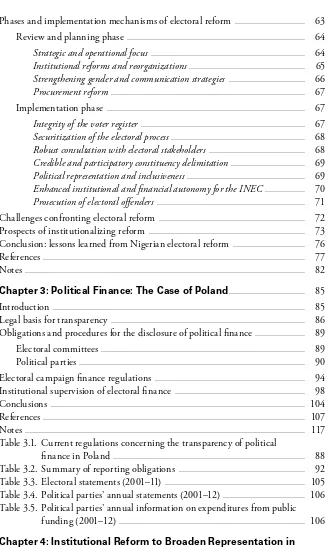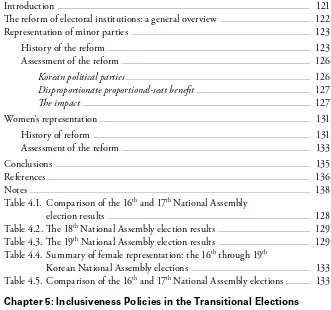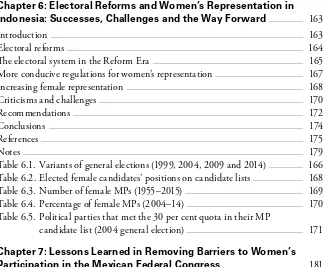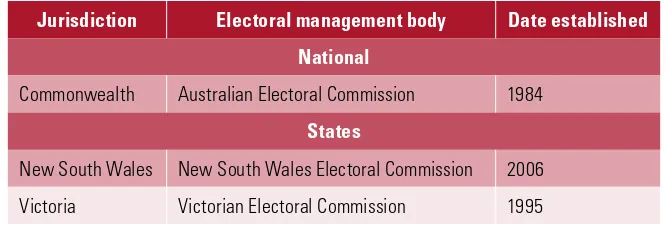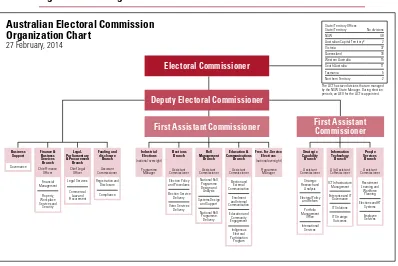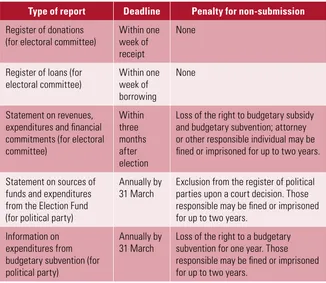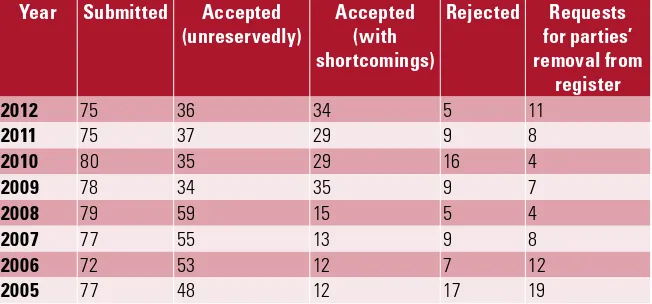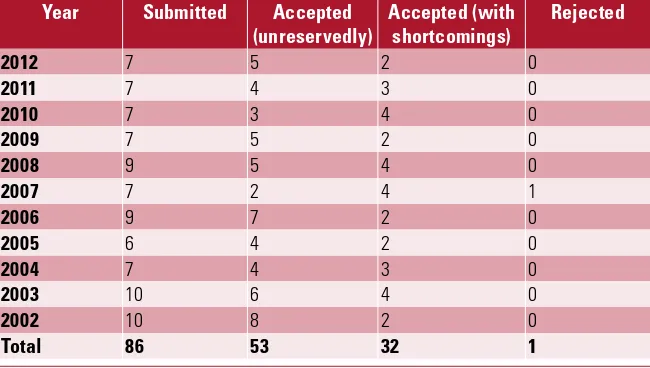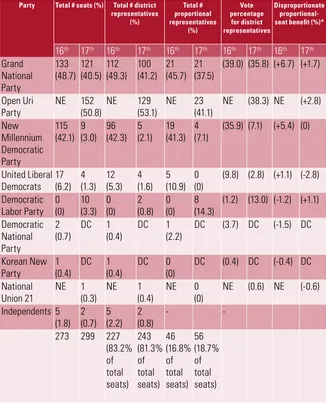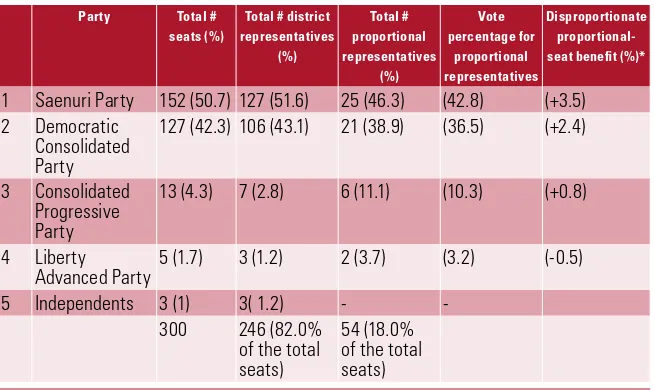International IDEA
Strömsborg, SE-103 34, Stockholm, Sweden
Tel: +46 8 698 37 00 Fax: +46 8 20 24 22 E-mail: info@idea.int Website: www.idea.int
Community of Democracies Permanent Secretariat
Aleje Ujazdowskie 41; 00-540 Warsaw, Poland Tel: +48-22-3195620
Fax: +48-22-3195628
E-mail: info@community-democracies.org Website: http://www.community-democracies.org/
This publication is independent of speciic national or political interests. Views expressed in this publication do not necessarily represent the views of International IDEA, its Board or its Council members, or those of the Community of Democracies or the Foreign Ministry of the Republic of Korea.
The electronic version of this publication is available under a Creative Commons Licence (CCl) – Creative Commons Attribute-NonCommercial-ShareAlike 3.0 Licence. You are free to copy, distribute and transmit the publication as well as to remix and adapt it provided it is only for non-commercial purposes, that you appropriately attribute the publication, and that you distribute it under an identical licence. For more information on this CCl, see: <http://creativecommons.org/licenses/by-nc-sa/3.0/>.
Graphic design by: Turbo Design, Ramallah Cover Photo: FutUndBeidl/Flickr Printed in Sweden
ISBN: 978-91-87729-67-6
Contributors: Paloma Biglino Kehinde Bolaji Amor Boubakri
Alberto Guevara Castro Raul Cordenillo Norm Kelly Firman Noor Byoung Kwon Sohn Slawomir Szyszka
Editor:
Raul Cordenillo
“Elections are the essential root of democracy. hey are now almost universal.” As Koi Annan indicates in Deepening Democracy: A Strategy for Improving the Integrity of Election Worldwide, nowadays, electoral processes are a reality in almost all the countries of the world. he development of an equitable, transparent and fair electoral process is the foundation for the strengthening of a healthy democracy. Given the multiplication of democratic electoral processes around the world, however, new challenges and needs have emerged. To meet these needs, the electoral process must be undergirded by two fundamental standards: credibility and integrity.
In order to ensure that these two crucial elements are present and visible, other features, such as respect for the rule of law, political plurality, transparency, accountability and the professionalization of electoral management bodies, among others, are necessary. Obviously though, theory is easier than practice, and, in that light, the publication Improving Electoral Practices: Case Studies and Practical Approaches provides practical direction through eight case studies, in accordance with three recommendations made by the Report of the Global Commission on Election, Democracy and Security.
he text was developed within the framework of the Working Group on Elections of the Community of Democracies, together with International IDEA, and supported by the Republic of Korea. he Community of Democracies is a global intergovernmental coalition of states committed to the development of democracy around the world. Its members pledge to uphold the democratic values expressed in the Warsaw Declaration and to support them through a variety of initiatives. One of these initiatives is the Working Group on Elections.
Recognizing the imperatives of democratic elections throughout the world, the Working Group deines its mission as encouraging democratic and electoral practices through the promotion of international horizontal exchange and cooperation. he Group’s mandate addresses three principal areas:
1) Reinforcement of capacities of the EMB and strategic electoral stakeholders; 2) Promotion of electoral accessibility and participation; and
3) Improvement of electoral processes.
In order to achieve its mandate, the Group organizes capacity reinforcement programmes, democratic relection forums and comparative research and publications. All of these are instruments that promote thinking and debate on the current state of world democracy.
he Working Group recognizes the importance of learning through the exchange of experiences. Improving Electoral Practices: Case Studies and Practical Approaches promotes knowledge through the realities and lessons learned from diferent countries, and allows us to recognize the challenges and their solutions to strengthen democratic institutions. It is a study that falls within the mandate of the Group, highlighting best practices in these areas of electoral reform. Moreover, the three issues within this document, the professionalization of electoral management bodies, political inancing and plural participation, are integral to an electoral process that is based on credibility and integrity. When these items are instituted, the election’s authority is strengthened by providing transparency and legitimacy.
his publication is a platform for relection on the current state of the democratic system. he lessons and experiences expressed within it show where new challenges have emerged and how they are overcome. It is a vision that reveals eight particular cases, yet illustrates the reality of many others. Finally, I want to inish with Koi Annan’s relection, ‘I believe the time is ripe to underscore the rule of law, democratic governance and citizen empowerment as integral elements to achieving sustainable development, security and a durable peace’. We, the Working Group, fully agree.
Manuel Carrillo
Introducing reforms to improve the conduct of democratic elections is not a straightforward process. First, we need to assess the soundness and efectiveness of existing policy. We need to determine the gaps and shortcomings, and evaluate whether policy reforms are the best way of addressing them. Furthermore, we have to consult with all relevant stakeholders, particularly women and marginalized groups. he outcomes of the assessment and consultations will indicate the direction of the reforms. hey can also inform a plan that will guide the reform process.
Second, and crucially, there must be political will to reform. A dedicated group of stakeholders can help ensure this by actively lobbying for reforms, engaging policymakers and civil servants, and contending with those who oppose reforms because it will impact their vested interests. Ideally, a political champion who can watch over the reform process will come forward. his publication, Improving Electoral Practices: Case Studies and Practical Approaches, follows up on the recommendations put forward by the Global Commission on Elections, Democracy and Securityto promote the integrity of elections. In particular, it shares experiences and lessons learned from eight countries that have undertaken electoral reforms to improve the professionalism and independence of action of their electoral management bodies, the regulation of political inance and the removal of barriers to universal and equal participation.
will help inform, as well as inspire, policymakers and advocates interested in successful electoral reform.
Yves Leterme Secretary-General International IDEA
Maria Leissner Secretary-General
he production of this book would not have been possible without the kind support and contributions of a number of individuals, organizations and states.
First, we would like to acknowledge the administrative oversight and contributions of the Permanent Secretariat of the Community of Democracies, particularly Francesco Lembo, as well as the inancial support provided by the Ministry of Foreign Afairs of the Republic of Korea.
We also would like to express our gratitude to the Community of Democracies Working Group on Elections, which supported the realization of this book and validated its country cases and indings. he Working Group is co-chaired by Mexico and the Philippines and its members include the Republic of Korea, the elections management bodies of Romania, India and Mexico, International IDEA, the Open Society Foundation, the National Democratic Institute, the Organization for Security and Co-operation in Europe’s Oice for Democratic Institutions and Human Rights and the International Foundation for Electoral Systems.
AEC Australian Electoral Commission AG Action Group (Party)
ALP Australian Labor Party
ATSIEEIS Aboriginal and Torres Strait Islander Election Education and Information Service
CABER Commissioner’s Advisory Board for Electoral Research
CEDAW Convention for the Elimination of All Forms of Discrimination against Women
COFIPE Codigo Federal de Insitutionces y Procedimientos Electorales (Federal Code of Electoral Institutions and Procedures)
CPEUM Constitución Política de los Estados Unidos Mexicanos (Political Constitution of the United Mexican States)
CPI Consumer Price Index CSOs Civil society organizations
DGD Democratic Governance for Development DLP Democratic Labor Party
DPD Dewan Perwakilan Daerah (Regional Representatives Council)
DPR Dewan Perwakilan Rakyat (People’s Representative Council or House of
Representatives)
ECANZ Electoral Council of Australia and New Zealand ECN Electoral Commission of Nigeria
ECOWAS Economic Community of West African States EMB Electoral management body
EVT Electronic voting trial FCT Federal Capital Territory FEDECO Federal Electoral Commission FPTP First past the post
ICCES Inter-Agency Consultative Committee on Election Security ICT Information and communication technology
IFE Instituto Nacional Electoral (Federal Electoral Institute)
IPAC Inter-Party Advisory Committee
ISIE Instance Supérieure Indépendante pour les Elections (High Independent Authority for Elections)
IU Izquierda Unida (United Left)
JSCEM Joint Standing Committee on Electoral Matters
KPU Komisi Pemilihan Umum (Election Commission)
MP Member of parliament
NASRDA National Space Research and Development Agency NEC National Election Commission
NEO National Election Oice NCA National Constituent Assembly NOA National Orientation Agency NIDD National Identity Cards Database NSW New South Wales
NYSC National Youth Service Corps
PIANZEA Paciic Islands, Australia and New Zealand Electoral Administrators’ Network
PP Partido Popular (Popular Party)
PR Proportional representation
PSOE Partido Socialista Obrero Español (Congress of the Spanish Socialist Workers Party)
PDP People’s Democratic Party PUP Palmer United Party
RERC Registration and Election Review Committee
RCD Rassemblement constitutionnel démocratique (Democratic Rally Party)
SBF Stefan Batory Foundation
Foreword ... 4
Preface ... 6
Acknowledgements ... 8
Abbreviations ... 9
Table of contents ... 11
Introduction ... 17
On the integrity of elections ... 17
he project, case selection and case studies ... 18
On reforming electoral processes ... 19
Overview of the chapters ... 20
References ... 22
Chapter 1: Professionalism of Electoral Management Bodies: The Australian Case ... 25
Introduction ... 25
Origins and roles ... 26
Independence of EMBs ... 31
Parliamentary oversight of electoral administration ... 33
Transfer of expertise ... 36
Marginalized groups and women ... 38
When systems fail ... 40
Conclusions ... 41
References ... 43
Notes ... 46
Table 1.1. Establishment of electoral commissions ... 26
Figure 1.1. AEC organizational structure ... 29
Chapter 2: Toward Institutionalizing Credible Elections in Nigeria: A Review of Reform Measures by the Independent National Electoral Commission ... 49
Introduction ... 49
Historical overview of elections in Nigeria ... 51
Institutional mandate and organizational design of the INEC ... 56
Strategic and operational focus ... 64
Institutional reforms and reorganizations ... 65
Strengthening gender and communication strategies ... 66
Procurement reform ... 67
Implementation phase ... 67
Integrity of the voter register ... 67
Securitization of the electoral process ... 68
Robust consultation with electoral stakeholders ... 68
Credible and participatory constituency delimitation ... 69
Political representation and inclusiveness ... 69
Enhanced institutional and inancial autonomy for the INEC ... 70
Prosecution of electoral ofenders ... 71
Challenges confronting electoral reform ... 72
Prospects of institutionalizing reform ... 73
Conclusion: lessons learned from Nigerian electoral reform ... 76
References ... 77
Notes ... 82
Chapter 3: Political Finance: The Case of Poland ... 85
Introduction ... 85
Legal basis for transparency ... 86
Obligations and procedures for the disclosure of political inance ... 89
Electoral committees ... 89
Political parties ... 90
Electoral campaign inance regulations ... 94
Institutional supervision of electoral inance ... 98
Conclusions ... 104
References ... 107
Notes ... 117
Table 3.1. Current regulations concerning the transparency of political inance in Poland ... 88
Table 3.2. Summary of reporting obligations ... 92
Table 3.3. Electoral statements (2001–11) ... 105
Table 3.4. Political parties’ annual statements (2001–12) ... 106
Table 3.5. Political parties’ annual information on expenditures from public funding (2001–12) ... 106
History of the reform ... 123
Assessment of the reform ... 126
Korean political parties ... 126
Disproportionate proportional-seat beneit ... 127
he impact ... 127
Women’s representation ... 131
History of reform ... 131
Assessment of the reform ... 133
Conclusions ... 135
References ... 136
Notes ... 138
Table 4.1. Comparison of the 16th and 17th National Assembly election results ... 128
Table 4.2. he 18th National Assembly election results ... 129
Table 4.3. he 19th National Assembly election results ... 129
Table 4.4. Summary of female representation: the 16th through 19th Korean National Assembly elections ... 133
Table 4.5. Comparison of the 16th and 17th National Assembly elections ... 133
Chapter 5: Inclusiveness Policies in the Transitional Elections in Tunisia ... 141
Introduction ... 141
he new election legal framework: toward equitable representation ... 143
Broad representation of political groups ... 144
he parity rule and the promotion of women’s representation ... 147
Youth: Zouaoua’s soldiers ... 148
Inclusion of marginalized regions ... 149
he exceptional inclusion of Tunisians abroad ... 151
he role of the new electoral administration in an inclusive electoral process .... 152
Protecting the emerging democracy and the challenges of inclusive elections ... 155
Conclusions ... 156
References ... 157
Table 5.1. Representation of political groups in parliamentary elections (1956–2009) ... 145
Table 5.2. Representation of political groups in the transitional elections ... 146
Introduction ... 163
Electoral reforms ... 164
he electoral system in the Reform Era ... 165
More conducive regulations for women’s representation ... 167
Increasing female representation ... 168
Criticisms and challenges ... 170
Recommendations ... 172
Conclusions ... 174
References ... 175
Notes ... 179
Table 6.1. Variants of general elections (1999, 2004, 2009 and 2014) ... 166
Table 6.2. Elected female candidates’ positions on candidate lists ... 168
Table 6.3. Number of female MPs (1955–2015) ... 169
Table 6.4. Percentage of female MPs (2004–14) ... 170
Table 6.5. Political parties that met the 30 per cent quota in their MP candidate list (2004 general election) ... 171
Chapter 7: Lessons Learned in Removing Barriers to Women’s Participation in the Mexican Federal Congress ... 181
Introduction ... 181
Institutional and historical background ... 183
Who is represented in Mexican democratic institutions, and how? ... 183
Mexico’s electoral system ... 184
Quotas: international environment and the road to women’s representation in parliament ... 185
International environment ... 185
First steps toward the introduction of quotas ... 186
Strengthening the rule of law: the role of the Electoral Tribunal ... 190
Judicial intervention to guarantee the implementation of quotas: reasoning and main decisions by the Electoral Tribunal ... 190
Data analysis ... 192
Increased presence of women in the lower house: time and quotas matter .. 192
Conclusions: the road toward improving the quality of equality ... 193
References ... 194
Appendix ... 197
Bivariate regression model ... 197
Trivariate regression models ... 198
Table 7.2. Registered candidates to the lower house by gender (1994-2000) ... 187
Figure 7.1. Percentage of women in the Mexican Federal Congress (1952–2012) .... 184
Figure 7.2. Percentage of female candidates for the lower house nominated by the three major political parties (1994–2012) ... 188
Chapter 8: Equal Representation in Spain: Lessons Learned from Balanced Electoral Lists ... 203
Introduction ... 203
Where we were ... 204
Where we are ... 205
What the law says ... 205
How the system works ... 208
he supervision of balanced lists ... 208
he consequences of non-compliance: the Garachico case ... 209
Balanced lists, equality and freedom in the jurisprudence of the Constitutional Court ... 211
Balanced lists vs. zipper lists ... 213
On balanced lists ... 213
Advantages of balanced lists ... 214
Conditions for establishing balanced lists ... 215
Conclusions ... 216
Requirements for implementing balanced lists: sanctions for non-compliance ... 217
References ... 219
Notes ... 222
Conclusion ... 227
Professionalizing EMBs ... 227
Regulating political inance ... 230
Removing barriers to political participation ... 231
Improving women’s political participation ... 232
Electoral reform ... 233
Recommendations for countries in democratic transition ... 234
Notes ... 235
About the Contributors ... 236
Raul Cordenillo
Holding regular elections is an integral part of any functioning democracy. Elections give citizens the opportunity to participate in the political process by allowing them to identify and select their political representatives. hese representatives, in turn, consult citizens, aggregate their political preferences and ensure that they are heard in democratic institutions and processes. In anticipation of elections, citizens—through various forums, including their respective political parties—acquaint themselves with the candidates for election and discuss and debate the burgeoning issues related to governance, the economy and the overall state of their country. After elections, citizens hold their elected representatives accountable to ensure that their political interests are heard and appropriately addressed. Failing to do so might make citizens rethink their choice of representatives for the next elections.
On the integrity of elections
If elections lack integrity, there is no opportunity for citizens to participate and advance their interests in the political process. In such cases, oicials and election management bodies (EMBs) are also not accountable to the citizens, and the results of elections are not transparent. hus, citizens may lose conidence in the election process.
who represent their citizens’ interests. As such, democratic governments serve their strategic interests by supporting elections with integrity.
he report identiied ive major challenges to conducting elections with integrity: (1) the implementation of the rule of law and electoral justice; (2) the professionalism and independence of EMB actions; (3) the establishment of institutions and norms of multiparty competition; (4) the removal of barriers to universal and equal participation; and (5) the regulation of political inance. he report then made recommendations to match these challenges and encourages governments, international organizations and various other sectors to implement them.
The project, case selection and case studies
he Community of Democracies Working Group on Elections, the Permanent Secretariat of the Community of Democracies and International IDEA, with the support of the Republic of Korea, undertook a project to look closely at the Global Commission’s recommendations, particularly the creation of professional and competent EMBs with full independence of action; oversight over political inance; and the removal barriers to the participation of women, youth and traditionally marginalized groups. he objective was to look at practical approaches to their implementation, as well as to identify good practices and lessons learned that could beneit democracies in transition. Case studies were commissioned on eight countries, which comprise the chapters of this book. hese include Australia, Indonesia, the Republic of Korea, Mexico, Nigeria, Poland, Spain and Tunisia. hey were selected to include participating states of the Community of Democracies from all continents and at diferent levels of political and economic development. Together, they represent diferent models of democracy, forms of government and electoral systems. While the eight countries do not necessarily constitute a representative sample of all democracies worldwide, they possess experiences that are relevant to the project.
chapters on Indonesia, Mexico and Spain focus on removing barriers to the participation of women.
Each chapter presents the country’s constitutional and legal framework, as well as current practices in the conduct and management of elections. It then identiies the electoral reform processes that were aimed at implementing the relevant Global Commission recommendation and highlights achievements, challenges and lessons learned by that country.
he chapters conclude with a set of recommendations that could help electoral authorities and electoral stakeholders initiate locally owned and inclusive processes leading to change and improvement in electoral processes, particularly for countries in transition. In so doing, this book, and the project as a whole, fulils the objectives of the Community of Democracies Working Group on Elections and the mandate of International IDEA.
On reforming electoral processes
Since this book tackles electoral systems and their reform, it is important to highlight their key characteristics. According to Electoral System Design: he New International IDEA Handbook, the choice of electoral system is one of the most important institutional decisions of any democracy. While electoral systems have a signiicant impact on the political life of the country concerned, it is only recently that there has been a conscious efort to select and design such systems. Traditionally, they have been the result of circumstance, colonial experience or even the inluence of neighbouring countries.
Moreover, electoral systems, once chosen, often remain fairly constant as political interests solidify around them and respond to the incentives presented by them. As such, reform of electoral systems is not an easy venture. It is often piecemeal, requiring political will, time, resources, national advocates and, at times, even external developments that impact the country. he interplay among these factors could vary from country to country.
Overview of the chapters
Chapter 1, ‘Professionalism of Electoral Management Bodies: he Australian Case’, presents the experience of a professional electoral administration operating in a long-established, well-resourced democracy. In particular, it highlights the strengths of the Australian system, which include a non-partisan, professional, public-sector work ethic, career-path opportunities for oicials and a relatively substantial budget. It also discusses areas for improvement, which relate to the lack of oversight over key aspects of the budget and limits on the independence and oversight of the EMB. It concludes with lessons that may be relevant to countries in transition.
Chapter 2, ‘Toward Institutionalizing Credible Elections in Nigeria: A Review of Reform Measures by the Independent National Electoral Commission’, focuses on the ongoing reforms since the 2007 elections in Nigeria. It presents the political context of election administration in the country and its institutional mandate and organization. It then discusses why electoral reform was necessary and how this was undertaken, including its core elements. his is followed by a discussion of the challenges faced and how these were addressed and could be managed better. he important lessons learned in the Nigerian electoral reform process are outlined in the concluding section.
Poland’s experience of shaping and applying political inance regulations is discussed in Chapter 3, ‘Political Finance: he Case of Poland’. It focuses on four areas of this rather broad topic, including the evolution of the legal basis for the transparency of political inancing in Poland, the obligations and procedures for disclosure for both political parties and electoral committees, provisions of the Election Code that regulate electoral campaigns and institutional supervision by the National Election Commission. he chapter describes the reform process undertaken in Poland to regulate political inance and highlights lessons that may be relevant to other countries, including those in transition.
he experience of Tunisia, particularly during the transitional elections held on 23 October 2011, is presented in Chapter 5, ‘Inclusiveness Policies in the Transitional Elections in Tunisia’. he chapter examines the policies of inclusiveness carried out in the framework of the democratic transition process in Tunisia and evaluates their contribution to the inclusion of individuals and groups that had been victims of deliberate political exclusion under the old regime. he lessons that can be learned from the experience of Tunisia’s transitional elections could help increase inclusiveness in post-transition electoral processes elsewhere as well.
Chapter 6, ‘Electoral Reforms and Female Representation in Indonesia: Successes, Challenges and the Way Forward’, discusses the improvement in female representation in the Indonesian Parliament as a result of recent reforms in the electoral system, in particular the use of open candidate lists and the zipper system. It also highlights gaps in policy that could be considered to further improve the system and suggests policy recommendations for policymakers in Indonesia and beyond.
Chapter 7, ‘Lessons Learned in Removing Barriers to Women’s Participation in the Mexican Federal Congress’, describes almost two decades of legal eforts to dismantle obstacles to women’s participation in democratic processes and, more speciically, to improve the descriptive and substantive representation of women in Congress at the national level in Mexico. In particular, it highlights the use of gender quotas and the role of the Electoral Tribunal of the federal judiciary, which have both contributed to reinforcing legal certainty and strengthening the rule of law. It concludes with lessons learned from the reform process that may be useful for improving electoral processes elsewhere.
he Spanish experience with regard to fostering equal opportunities for men and women is presented in Chapter 8, ‘Equal Representation in Spain: Lessons Learned from Balanced Electoral Lists’. In particular, it highlights the reform process following the introduction of Law 3/2007 on Efective Equality between Women and Men and the impact of balanced electoral lists on the electoral system as a whole. It highlights the role played by electoral commissions, courts of law and the Constitutional Court as principal custodians of equal representation. he chapter concludes with lessons learned that can be helpful as a guide for electoral reforms aimed at fostering women’s equal representation.
Yet there are also commonalities among them, particularly in terms of challenges to electoral reform and how to address them. hese diferences and commonalities, as well as the indings and recommendations of the chapters, are summarized in the conclusion of this book.
References
Reynolds, Andrew et al., Electoral System Design: he New International IDEA Handbook (Stockholm: International IDEA, 2008)
he Global Commission on Elections, Democracy and Security, Deepening Democracy: A Strategy for Improving the Integrity of Elections Worldwide
Norm Kelly
Professionalism of Electoral
Management Bodies: The
Australian Case
Introduction
Australia provides a compelling case study of a professional electoral administration operating in a long-established, well-resourced democracy. Its electoral management bodies (EMBs) at the national and sub-national levels have many strengths, including a long-established culture of a non-partisan, professional public-sector work ethic; career opportunities for EMB staf; and the competent management of boundary redistributions, party registration and public funding regimes. he budgets of Australian EMBs are quite substantial compared to those of many other countries, which corresponds to a public expectation of high performance from electoral administrators. However, there are also several areas of concern, including limited control over key aspects of an EMB’s budget, limits to their independence in administering elections, legislation designed to provide a partisan advantage and the lack of non-partisan oversight of EMB performance.
of indigenous and women’s representation in Australia. hen, the chapter considers the implications of an election failure, as it occurred in 2013 in Western Australia. It concludes with a summary of Australia’s successes and lessons learned, and how they are relevant to countries in transition.
Origins and roles
he origins of Australia’s professionalized electoral administration lie in pre-federation colonial society, when electoral administration was primarily the responsibility of public servants working in existing government departments. When the federation was established in 1901, legislative responsibilities were split between the national (federal) parliament and state legislatures;1 the
powers of each, including the jurisdictions responsible for conducting elections, were deined in the constitution. Electoral administrations continued to be part of the public service, but, over time, they achieved greater independence from government by establishing statutory oices; however, these remained subject to ministerial direction. At the national level, the Australian Electoral Commission (AEC) was established by the Commonwealth Electoral Legislation Amendment Act of 1983.2 Although the AEC is regarded as an
independent EMB, the government has retained control over budgetary and legislative matters (Hughes 2001).
At Australia’s sub-national state and territory levels, each jurisdiction has experienced a similar evolution in electoral administration and governmental inluence: all states and mainland territories established electoral commissions from 1987 through 2009 (see Table 1.1). Australia has three tiers of government (national, state and territory, local), and local government elections are typically administered by (or with the assistance of) the relevant state or territory commission. In 2008, there were more than 550 local government bodies across Australia (Sawer, Abjorensen and Larkin 2009: 262).
Table 1.1. Establishment of electoral commissions
Jurisdiction Electoral management body Date established
National
Commonwealth Australian Electoral Commission 1984
States
New South Wales New South Wales Electoral Commission 2006
Queensland Electoral Commission of Queensland 1992
Western Australia Western Australian Electoral Commission 1987
South Australia Electoral Commission of South Australia 2009
Tasmania Tasmanian Electoral Commission 2005
Territories
Australian Capital Territory
Australian Capital Territory Electoral Commission
1992
Northern Territory Northern Territory Electoral Commission 2004
Source: Author
he AEC is headed by three commissioners: a full-time chief executive, a senior judge as the part-time chairman and a part-time commissioner, who usually has statistical skills (currently the Australian statistician) due to the importance of boundary redistributions. Commissioners are appointed by the governor-general on the recommendation of the government of the day. he government is not required to consult with opposition parties or to vet potential appointees through an independent mechanism. Although there is the potential for partisan appointments to be made, which would diminish the organization’s independence, to date this has not been done. he chief executive commissioners appointed since 1983 have been oicials with a strong background in electoral administration or public-sector management roles.
he independence of electoral commissioners has not been a signiicant issue in Australia, but other factors, in addition to the appointment process, that can afect commissioners’ independence include the length and security of their tenure. If a commissioner lacks long-term security, then his or her actions may be (or perceived to be) related to a desire for reappointment. When the timing of a potential reappointment coincides with an election, this may also have an impact, regardless of the length of appointment. It can be expected that the longer the length of an appointment, the more conidence a commissioner will have to act independently. However, other issues, such as being innovative and having the ability to replace an underperforming commissioner, also need to be considered.
AEC commissioners are appointed for up to seven years. he ‘up to’ provision gives governments some lexibility to determine the length of an appointment, and, in reality, AEC commissioners are typically appointed for ive years, which is consistent with government policy on senior appointments. Shorter-term appointments could be associated with weaker independence, especially if the commissioner is seeking reappointment. In sub-national jurisdictions, the length of tenure ranges from ‘up to ive years’ for the Australian Capital Territory (ACT) and Northern Territory through to appointments to the age of 65 for South Australian commissioners (Kelly 2012: 41). All jurisdictions prescribe the circumstances under which a commissioner may be dismissed, such as bankruptcy and mental or physical incapacity, and all jurisdictions except for the national and Queensland commissions require a parliamentary resolution in order for a dismissal to take efect.
Figure 1.1. AEC organizational structure3
Source:<http://www.aec.gov.au/About_AEC/iles/aec-org-chart.pdf>.
In between conducting federal elections, which are due every three years, the AEC’s work includes management of the electoral roll (enrolling new electors and updating the details of existing electors), community education, legislative review and staf training for election events. he AEC also conducts industrial elections (such as trade union elections) on a fee-for-service basis, and AEC staf provide assistance in overseas elections as part of Australia’s aid programme. he AEC also provides administrative and technical support for electoral-boundary redistributions, which are conducted according to part IV of the Commonwealth Electoral Act of 1918 by committees made up of AEC and state oicials. Redistributions are conducted on a state-by-state basis, and the timing is speciied by section 59 of the act.
he AEC is also responsible for maintaining the register of political parties, according to part XI of the act. his work includes processing new applications and reviewing whether parties remain eligible for registration. For the 2013 election, 54 parties were registered, including 22 that were registered in the nine months before the election. his can create a heavy
Electoral Commissioner
Deputy Electoral Commissioner
First Assistant Commissioner First Assistant Commissioner
The ACT has two divisions that are managed by the NSW State Manager. During election periods, an AEO for the ACT is appointed
Business Support Finance & Business
administrative load on the commission to verify that submitted membership names are eligible to meet the minimum 500-member threshold to register. here is also an appeals process through which people can lodge objections to the registration (for example, on the grounds that the party name could be confused with that of another party). he AEC is responsible for deciding whether an application to register a party should be allowed. If it is rejected, the party can appeal the decision to the Administrative Appeals Tribunal, a separate agency that independently reviews decisions made under the power of national legislation.4
he AEC is also responsible for administering party and candidate funding and disclosure schemes and conducting compliance reviews. By international standards, Australia’s political inance laws are relatively weak. Disclosure returns are required from political parties, donors and associated entities, but may be submitted more than a year after an election, thus negating their value in identifying sources of inluence in elections. Political parties and candidates have few limitations on who they can accept money from, and there are no limits on how much can be raised from private donations or spent on election campaigns. he threshold for disclosing donations is also quite high—it was raised from $1,500 to $10,000 in 2006 (and is now $12,400, due to mandatory Consumer Price Index (CPI) increases)—which exempts many donations from disclosure.5
A public funding system based on an amount per vote has been in place since 1983. Candidates and parties that achieve a minimum of 4 per cent of the vote receive a speciied amount for each vote received. At its inception, the average amount received was $0.45 per vote,6 which has steadily risen
to $2.53 per vote with CPI increases. his equates to more than $5.00 per vote for each election if a voter supports the same party for both houses. Unlike many countries, where public funding is used to replace, minimize or restrict the inluence of private donations, the Australian system allows public funding in addition to private donations.
One of the signiicant beneits of the provision of public funding in Australia is that its introduction has been accompanied by inancial reporting and disclosure regimes. Parties and donors are required to lodge annual returns, while candidates must lodge election disclosure returns. hese are published on the AEC website,7 which provides a database of disclosures since 1998.
match information provided by parties and candidates in order to maximize the possibility of identifying any non-disclosures (by the party, candidate or donor).
All electoral commissions at the Australian sub-national level have similar responsibilities and structures as the AEC. One exception is New South Wales (NSW), where the NSW Election Funding Authority administers party registration, public funding and inancial disclosure. Although the authority is legally separate from the NSW Electoral Commission, this separation is largely symbolic, as the NSW electoral commissioner is also the authority chair, and the commission provides staing and support to the authority. he signiicant diference is that the other two members of the authority are nominated by the government and opposition, which makes it the only EMB in Australia with partisan-based appointments. his creates a perception of political bias, and can jeopardize the perceived independence of the electoral commissioners. his is particularly important, as the authority has the power to initiate legal proceedings against candidates who do not comply with the requirements of the Election Funding, Expenditure and Disclosures Act of 1981. his creates a clear conlict of interest, as the two nominated members are in a position to decide whether legal action should be commenced against their own party colleagues. Although having an independent chair holding the deciding vote may prevent blatantly partisan decisions that favour one party over the other, it does not prevent the two partisan appointees from colluding against other parties and candidates (Kelly 2012: 10–1).
Independence of EMBs
International IDEA classiies the Australian system as an example of the Independent model of electoral administration. However, there are three important criteria for independence that the AEC does not meet: powers,
formal accountability and budgetary control. In these three respects, the AEC conforms more to IDEA’s Government or Mixed models. With regard to the power criterion, the AEC does not have the authority to independently develop its regulatory framework. his power resides with the parliament and government of the day, which, critically, limits the AEC’s ability to operate independently. While it can easily be argued that a democratically elected parliament should be allowed to legislate for its EMBs, the partisan inluence and level of detail in the Australian legislation appears excessive.
One example of the extent to which legislation, driven by partisan objectives, dictates electoral administration can be seen in the ten pages of detail in section 90B of the Commonwealth Electoral Act of 1918. his section requires the AEC to provide electoral-roll information to political parties for campaigning purposes, to the exclusion of other electoral competitors. Such privileged access to electoral information would not be possible in a truly independent system. Another example of partisan inluence is legislation passed in 2004 to amend section 48 of the act, in relation to the boundary-redistribution processes. he amendment was developed by the coalition government and Labor opposition to require the AEC to ignore previously established rules for boundary redistributions for Northern Territory seats. his example of party cartel behaviour had a clear partisan impact on representation.8
an electoral education programme for indigenous voters. he Aboriginal and Torres Strait Islander Election Education and Information Service (ATSIEEIS) programme was centred in electorates with large populations of indigenous citizens, a demographic with traditionally low levels of voter enrolment and turnout. ATSIEEIS had operated for almost 20 years, and was considered instrumental in improving enrolment and turnout rates. he abolition of the programme was seen to advantage right-of-centre coalition parties, as indigenous people are seen to be predominantly left-of-centre voters. Importantly, it prevented the AEC from being able to independently decide on where its education programmes would be best targeted (Kelly 2012). In 2009, the Labor Government used its budgetary powers to force the closure of two AEC electoral education centres (Kelly 2011). Although this action did not have the same partisan implications as the ATSIEEIS cut, it is a similar example of limiting the AEC’s control over its own budget.
Parliamentary oversight of electoral administration
In a healthy democracy, there will most often be tension between the independent operation of a fair electoral system and political players who want to maximize their results within the system. It can be argued that there should be ongoing tension between the electoral system and political parties, where each is attempting to exert dominance, or at least inluence, over the other.9 To prevent political parties from dominating the electoral
system through the actions of their parliamentary representatives, ideally an independent watchdog will oversee the actions and performance of both the administrator of the system—in this case, the AEC—and the political participants in elections.
Australia does not have such an independent body. he primary vehicle for oversight over the AEC’s activities is the Joint Standing Committee on Electoral Matters (JSCEM), which was established in 1983.10 his committee
support a political party rather than individual candidates. MPs’ loyalty to their party is very strong, as they rely on their party ailiation to be elected. To reciprocate, the party expects elected representatives to act in its interests. herefore, parliamentary activity, and the work of the JSCEM, requires close scrutiny to determine whether MPs’ actions are based on principles of electoral fairness or on the MPs’ own self-interest and partisan considerations. JSCEM recommendations have often been made for political advantage rather than electoral best practice.
JSCEM committee members are appointed by their respective parties, so it should be no surprise that they act in their party’s interest. As a result, because the committee’s activities relate so closely to the future success of the parties, the JSCEM can be the most partisan parliamentary committee. he governing party is permitted a majority on the JSCEM, followed by representation from the opposition party, and typically one or two members representing other parties. By relecting the make-up of the parliaments, the committee can be perceived as simply reinforcing the status quo. In so doing, it creates a signiicant incumbency advantage, primarily for the incumbent government over the opposition and minor parties, but also for parties with parliamentary representation over non-parliamentary parties.
he provisions for postal voting provide a good example of partisan interests overriding independent electoral administration over the past couple of decades. he use of postal voting, where voters receive their ballot papers in the mail and then post them back to the AEC, has steadily increased during this period—from 2.8 per cent of all voters in the 1993 election to 8.3 per cent in 2013. he circumstances for when postal voting can be used have also expanded, and now include when a voter is outside their electorate on polling day; when a voter’s residence is not within 8 kilometres of a polling booth; illness, inirmity or approaching maternity; religious beliefs precluding attendance at a polling booth; when a voter is in prison; and work conditions that prevent attendance.
his growth in postal voting raises several questions regarding the integrity of elections, for example: are safeguards in place to ensure that postal voting is conducted without coercion or undue inluence, can election oicials be conident that a postal vote has been cast by the person stated on the electoral roll, and does the involvement of political parties in the distribution and collection of postal-voting application forms corrupt the process? he AEC has consistently made submissions to the JSCEM, criticizing this practice as politicizing the independent administration of elections. he AEC’s concerns include:
• the potential for voter confusion (thinking that the parties are responsible for postal voting rather than the AEC);
• the intention to disenfranchise voters (by delays in returning ballots to the AEC);
• the unnecessary use of postal voting increases costs and delays the inalization of results;
• political parties stockpile applications before sending them to the AEC, despite this being an ofence under section 197 of the act;
• the secrecy and integrity of the ballot may be compromised;
• parties attempting to obscure the fact that the application is returned to a party by using terms such as ‘returning oicer’; and
• party oicials ‘correcting’ details on applications before sending them to the AEC (Kelly 2012).
Despite these criticisms, the JSCEM and successive governments have chosen not to recommend ending this practice. AEC concerns in recent submissions have concentrated on the administrative delays in processing applications rather than the inherently partisan distribution of application forms.
Although committee inquiries may be inluenced by partisan interests, the JSCEM has facilitated a worthwhile relationship between the legislators and administrators of the electoral system. It conducts private brieings for the AEC twice a year, in which many politically non-contentious issues can be resolved. he AEC can raise administrative issues with the committee that may be resolved through minor amendments to legislation. Given the level of detail contained in the act, it is important that amendments can be readily made when required, and the JSCEM hearings process has become an efective mechanism to achieve this.
committees on an issue-by-issue basis. At both the national and state levels, these committee inquiries have given community and other representative organizations a voice and a forum to discuss the needs of their members. A good example of a committee inquiry process leading to positive reform is the introduction of an electronic voting trial (EVT) for blind and vision-impaired voters in the 2007 national election. he trial was implemented after the introduction of similar technology in earlier ACT territory elections, and submissions made to the 2004 national election inquiry from at least four organizations representing the interests of blind and vision-impaired citizens. he primary motivation for introducing the EVT was to allow all voters to vote in secret instead of having to tell an assistant how they wanted to vote. he EVT proved quite costly, since it was only used by 850 voters at 29 locations. Rather than persisting with the EVT for future elections, the JSCEM recommended that it be replaced by a telephone-based system, which was used for the 2010 and 2013 elections (JSCEM 2009: 13). Although the ETV was deemed a failure, the JSCEM process provided a mechanism for groups representing the disabled to lobby for changes to assist their constituents. Because of the regularity of election inquiries, the facilitation of opportunities for blind and vision-impaired citizens to vote in secret remains an issue that the AEC and JSCEM will continue to address and work on improving. For example, the JSCEM’s report on the 2010 election dedicated six pages to the issue (JSCEM 2011: 67–72), whereas it was not mentioned a decade earlier in the reports on the 1998 and 2001 elections.
Transfer of expertise
In addition to conducting industrial elections and the occasional referendum, the federal nature of Australia’s democracy provides a professional career path for electoral administrators and opportunities to transfer to (and be promoted between) state and national administrations. For example, of the nine chief executive commissioners in Australia in 2011, seven had previously held senior positions in another Australian electoral administration (Kelly 2012). his transfer of expertise and experience lows through the organizations, and encourages innovation and best practice. When an election is held, commissioners from the various jurisdictions meet to observe the conduct of the election, giving them practical, factual experience and an understanding of each other’s election environment and issues to address. Using the earlier issue of providing opportunities for blind and vision-impaired electors to vote in secret, EVTs have been held in recent years in federal, ACT, NSW and Victorian elections. his has enabled the testing of diferent systems, the results of which have been disseminated among, and analysed by, the various commissions.
As all Australian jurisdictions operate on either a three- or four-year electoral cycle, on average, two or three elections are held in the country each year (plus local government elections). herefore, administrators can observe trials regularly between their own elections. his encourages healthy competition between jurisdictions, with commissioners and administrators wanting to exhibit best-practice conduct to their colleagues. he Electoral Council of Australia and New Zealand (ECANZ)11—which consists of the chief electoral
administrator of each of the nine Australian jurisdictions and New Zealand’s chief electoral oicer—was established to provide cross-jurisdictional support: cooperation and coordination between electoral authorities is one of its key goals. here is a research element to ECANZ’s work, but the AEC also recently established its own research body, the Commissioner’s Advisory Board for Electoral Research (CABER),12 which is made up of academics and
other electoral experts. CABER’s role is to provide independent expert advice to the AEC on strategic research directions.
citizens held by the government, such as driver’s licence information, is used to automatically enrol people, without the need to ill out an application. Unfortunately, this type of data cannot be used in all jurisdictions. he transfer of expertise also has an international perspective: the AEC has a legislated responsibility to provide international electoral assistance where requested when it is approved by the Australian Government. For example, in 2012–3 assistance was provided to Bhutan, Indonesia, Nepal, Papua New Guinea, Timor-Leste and several Paciic countries. To assist in the development of professional electoral administration in the Paciic, the AEC provides support to the Paciic Islands, Australia and New Zealand Electoral Administrators’ Network (PIANZEA),13 whose forerunner was established
in the late 1990s. he beneits of PIANZEA include the provision of a cross-jurisdictional dialogue and support structure, in a similar way to that taking place at the Australia-New Zealand level. Another aspect of the AEC’s international assistance is its work in BRIDGE—Building Resources in Democracy, Governance and Elections—a framework of workshops, training modules and accreditation that focuses on developing electoral administrators and improving education and awareness among election stakeholders.14
Marginalized groups and women
Although Australia was the irst country in the world to provide women with the right to vote and stand for parliament (in 1902, see Sawer, Abjorensen and Larkin 2009: 119), the irst women were not elected to the national parliament until 1943 (McCann and Wilson 2012: 10). Women comprised under 10 per cent of all members of parliament until the 1980s. Women make up 31 per cent of the current parliament. Although this is a clear improvement, Australia continues to slip in the Inter-Parliamentary Union’s international rankings for women’s representation in lower or single houses—from 15th in
1999 to 43rd in 2013.15 his issue has been defused to a degree, and the greatest
focus is now on the number of female MPs from individual parties. Typically in Australia, women’s representation is greater in left-of-centre parties, such as the Greens (60 per cent) and ALP (43 per cent), than in the right-of-centre Liberal (21 per cent) and National (16 per cent) parties.
When systems fail
he AEC’s integrity was seriously questioned after the September 2013 national election in relation to the Western Australian half-Senate election ballot count. In half-Senate elections, six senators are elected from each state, using the single transferable vote counting system, which is a form of proportional representation. Using this system, voters indicate a full list of preferences: in the Western Australian case, 62 candidates contested, so voters were required to indicate preferences for all candidates, from 1 to 62 (or, as most voters do for convenience, vote for a party ticket with pre-determined preferences). he lowest-polling candidate is eliminated, and his/her votes are transferred to the next-preferred candidate on the ballot paper. After the initial count, the inal two Senate positions were won by the ALP and the Palmer United Party (PUP). Due to the closeness of the result—fewer than ten votes separated the two lowest-polling candidates in one elimination round—the AEC ordered a recount, following petitions from two losing candidates.
he recount resulted in the election of the two petitioning candidates, from the Greens and the Sports Party, at the expense of the ALP and PUP candidates. However, during the recount it was discovered that 1,370 ballot papers from the original count had gone missing. his resulted in the losing candidates and the AEC petitioning the High Court (sitting as the Court of Disputed Returns).16 he AEC also instigated an inquiry into what happened to the
missing ballot papers, and the inquiry report highlighted several failures in AEC counting processes, storage and transport procedures, use of external contractors and short-term staf, and tracking systems (Keelty 2013), but did not locate the missing ballots. In February 2014, the High Court ruled that the Western Australian Senate election was void, and that a fresh election was required.17
Because of these system failures and the voiding of the election, the AEC sufered a serious blow to its reputation. As a result, the AEC commissioner and the Australian electoral oicer for Western Australia resigned from their positions. here were several important lessons from this event in relation to the professionalism of Australian EMBs:
• he legislation contained adequate and timely appeal mechanisms with which to resolve the issue.
• he aggrieved parties had conidence in these mechanisms, and engaged in the legal process.
• he resignation of the senior AEC oicers conveyed the seriousness of the failure and the regard they held for the integrity of the AEC.
Conclusions
Australia has a strong, established democracy, yet its electoral administration could be made more professional. First, the provision of public funding in Australia has been complemented by greater transparency mechanisms to monitor the low of political money, but it is a relatively weak form of transparency, as disclosures occur well after an election, when the value of exposure is limited. In addition, public funding has not been accompanied by restrictions on private donations or campaign expenditures, meaning that public money is used to top up political parties’ other sources of funding rather than as a replacement for private money. A beneit of public funding, however, has been the growth of smaller parties, which can rely on this source of funding if they perform credibly at an election. Many countries now have some form of public funding for elections and political parties. here can be several beneits for democracies in transition to introduce public funding, including diminishing the inluence of private money and promoting multiparty democracy. Public funding can also be used as leverage for implementing other reforms, such as disclosure and reporting regimes, party registration and recognition on ballot papers.
To promote good governance, EMBs must be provided with an adequate budget that is not controlled by partisan interests. One way of making an EMB’s budget less political is to have it reviewed by an independent authority or at least by a parliamentary committee. Although parliamentary committees are made up of partisan interests, they can provide a forum for cross-party support. Such a process has been proposed for the Victorian Electoral Commission (PAEC 2006: 80–2) in order to open up the commission’s budget to the scrutiny of non-government parties and help strengthen its independence.
public—such as an auditor-general or ombudsman’s oice. Ideally, inquiries should be held soon after an election has taken place. Although a government and/or parliament may not necessarily adopt the recommendations from a public inquiry, the process creates an important public record of the issues and relevant positions of policymakers, and, through public exposure and debate, can create an impetus for reform.
he interaction between EMBs in Australia is very strong, and often leads successful innovations from one jurisdiction to be quickly adopted by other jurisdictions. he AEC’s international linkages with EMBs allow this experience and expertise to spread, and provide opportunities for Australian electoral administrators to gain experience and awareness of other countries’ systems. Quite often in democracies in transition, there will not necessarily be a culture of independent public service or a long-term career path for those wanting to become full-time electoral administrators. It therefore becomes more important to establish networks with EMBs in other jurisdictions to develop a sense of collegiality with other administrators in the region. he exchange of ideas and innovations, and the development of networks, can be invaluable. his is often done by observing each other’s elections, but it is also worthwhile to develop a regional network of electoral administrators, if one does not already exist, to facilitate ongoing support and exchanges.
can take the form of guaranteed seats in parliament or requiring parties to ield a speciied number of female candidates. hese measures have proven successful in many developing democracies, and are seen as an efective way for signatory countries to meet their obligations under the Convention on the Elimination of All Forms of Discrimination against Women.18
Finally, the failure of the 2013 Western Australian Senate election provides a salutary lesson that EMBs cannot aford to be complacent in managing their performance. While the AEC’s reputation has been seriously damaged by this failure, other processes, such as the JSCEM inquiry into the election, should enable new measures to be considered and implemented, to minimize the chances of such a failure occurring again.
References
ACE Electoral Knowledge Network, ‘EMB independence and the origin of independent election administrations’, 10 April 2007, available at <http://aceproject.org/electoral-advice/archive/questions/ replies/156664001>
Australian Bureau of Statistics, ‘2075.0—Census of Population and Housing—Counts of Aboriginal and Torres Strait Islander
Australians’, 2011, available at <http://www.abs.gov.au/ausstats/abs@. nsf/Lookup/2075.0main+features32011>
Australian Electoral Commission [AEC], Annual Report 2012-13 (Parkes, Australia: Australian Electoral Commission, 2013), available at <http://www.aec.gov.au/About_AEC/Publications/>
Benoit, Ken, ‘Models of Electoral System Change’, Electoral Studies, 23/3 (2004), pp. 363–89
Clark, Lesley and Rodrigues, Charmaine, Utilising Temporary Special Measures to Promote Gender Balance in Paciic Legislatures: A Guide to Options (Suva: United Nations Development Programme and Paciic Islands Forum Secretariat, 2009)
Dundas, Carl W., Dimensions of Free and Fair Elections: Frameworks, Integrity, Transparency, Attributes and Monitoring (London: Commonwealth Secretariat, 1994)
Elkins, David J., ‘Electoral Reform and Political Culture’, in Malcolm L. Alexander and Brian Galligan (eds.), Comparative Political Studies: Australia and Canada (Melbourne: Pitman, 1992)
Hughes, Colin, ‘Institutionalising Electoral Integrity’, in Marian Sawer (ed.), Elections: Full, Free & Fair (Sydney: he Federation Press, 2001) Joint Standing Committee on Electoral Matters [JSCEM], Report on the
Conduct of the 2007 Federal Election and Matters Related hereto
(Canberra: Commonwealth of Australia, 2009)
Joint Standing Committee on Electoral Matters [JSCEM], he 2010 Federal Election: Report on the Conduct of the Election and Related Matters
(Canberra: Commonwealth of Australia, 2011)
Jupp, James and Sawer, Marian, ‘Political Parties, Partisanship and Electoral Governance’, in Marian Sawer (ed.), Elections: Full, Free & Fair
(Sydney: he Federation Press, 2001)
Katz, Richard S. and Mair, Peter, ‘Changing Models of Party Organization and Party Democracy’, Party Politics, 1/1 (1995), pp. 5–28
Katz, Richard S. and Mair, Peter, ‘he Cartel Party hesis: A Restatement’,
Perspectives on Politics, 7/4 (2009), pp. 753–66
Keelty, Mick, Australian Electoral Commission Inquiry into the 2013 WA Senate Election (Canberra: Australian Electoral Commission, 2013), available at <http://aec.gov.au/About_AEC/Publications/Reports_On_ Federal_Electoral_Events/2013/iles/inquiry-into-the-2013-wa-senate-election.pdf>
Kelly, Norm, ‘Australian Electoral Administration and Electoral Integrity’, in Joo-Cheong ham, Brian Costar and Graeme Orr (eds.), Electoral Democracy: Australian Prospects (Carlton: Melbourne University Press, 2011)
Lloyd, Brian, ‘Dedicated Indigenous representation in the Australian Parliament’, 2009, available at <http://www.aph.gov.au/About_ Parliament/Parliamentary_Departments/ Parliamentary_Library/pubs/ rp/rp0809/09rp23>
Massicotte, Louis, Blais, André and Yoshinaka, Antoine, Establishing the Rules of the Game: Election Laws in Democracies (Toronto: University of Toronto Press, 2004)
McCann, Joy and Wilson, Janet, ‘Representation of Women in Australian Parliaments’, 2012, available at <http://www.aph.gov.au/About_ Parliament/Parliamentary_Departments/ Parliamentary_Library/pubs/ BN/2011-2012/Womeninparliament>
Mozafar, Shaheen and Schedler, Andreas, ‘he Comparative Study of Electoral Governance –– An Introduction’, International Political Science Review, 23/1 (2002), pp. 5–27
Orr, Graeme, he Law of Politics: Elections, Parties and Money in Australia
(Sydney: he Federation Press, 2010)
Orr, Graeme, Mercurio, Bryan and Williams, George, ‘Australian Electoral Law: A Stocktake’, Election Law Journal, 2/3 (2003), pp. 383–402 Public Accounts and Estimates Committee [PAEC], Report on a Legislative
Framework for Independent Oicers of Parliament (Melbourne: Parliament of Victoria, 2006)
Rae, Douglas, he Political Consequences of Electoral Laws (Clinton, MA: Colonial Press, 1967)
Reynolds, Andrew and Reilly, Benjamin, he International IDEA Handbook of Electoral System Design (Stockholm: International IDEA, 2002) Sawer, Marian, Abjorensen, Norman and Larkin, Phil, Australia: he State
of Democracy (Sydney: he Federation Press, 2009)
ham, Joo-Cheong, Money and Politics: he Democracy We Can’t Aford
(Sydney: UNSW Press, 2010)
Young, Sally and ham, Joo-Cheong, Political Finance in Australia: A Skewed and Secret System (Canberra: Democratic Audit of Australia, he Australian National University, 2006)
Notes
1 Territories, such as the Northern Territory and Australian Capital Territory, were given legislative
powers later.
2 The principal legislation governing the AEC and Australian elections is the Commonwealth
Electoral Act of 1918, which has been amended many times over the past century. The consolidated version of the act can be found at <http://www.austlii.edu.au/au/legis/cth/consol_act/cea1918233/>.
3 From the AEC’s website, <http://www.aec.gov.au/About_AEC/files/aec-org-chart.pdf>. 4 Information on the Administrative Appeals Tribunal can be found at <http://www.aat.gov.au/>. 5 For more information on financial disclosures, see <http://www.aec.gov.au/Parties_and_Representatives/
financial_disclosure/index.htm>.
6 $0.60 for House of Representatives votes, and $0.30 for Senate votes. 7 The AEC’s website can be found at <http://electiondisclosures.aec.gov.au/>.
8 Commonwealth Electoral Amendment (Representation in the House of Representatives) Act 2004. 9 Benoit (2004) describes this tension as the mechanical functioning of voting systems against
parties’ psychological behaviour.
10 Originally the Joint Select Committee on Electoral Reform, from 1983 to 1987. 11 The ECANZ website can be found at <http://www.eca.gov.au/>.
12 Information on CABER can be found at <http://www.aec.gov.au/About_AEC/research/caber/>. 13 Information on PIANZEA can be found at <http://www.aec.gov.au/About_AEC/AEC_Services/
International_Services/PIANZEA/>.
14 The BRIDGE website can be found at <http://www.bridge-project.org/>.
15 See the website of the Inter-Parliamentary Union at <http://www.ipu.org/iss-e/women.htm>. 16 The process for disputing election results is detailed in the Commonwealth Electoral Act of 1918,
part XXII.
Toward Institutionalizing
Kehinde Bolaji
Toward Institutionalizing Credible
Elections in Nigeria: A Review
of Reform Measures by the
Independent National Electoral
Commission
Introduction
Elections are essential in a democracy, and they are at the core of citizens’ democratic rights. Since the end of the Cold War, the reintroduction of multiparty democracy and the gradual reopening of the political space have ensured that holding elections is now the main acceptable means of political change in African countries.1 In addition, ‘credible competitive elections have
become a necessary, albeit suicient, source of behavioural, if not attitudinal, legitimacy in Africa’s emerging democracies’ (Mozafar 2002: 86).
